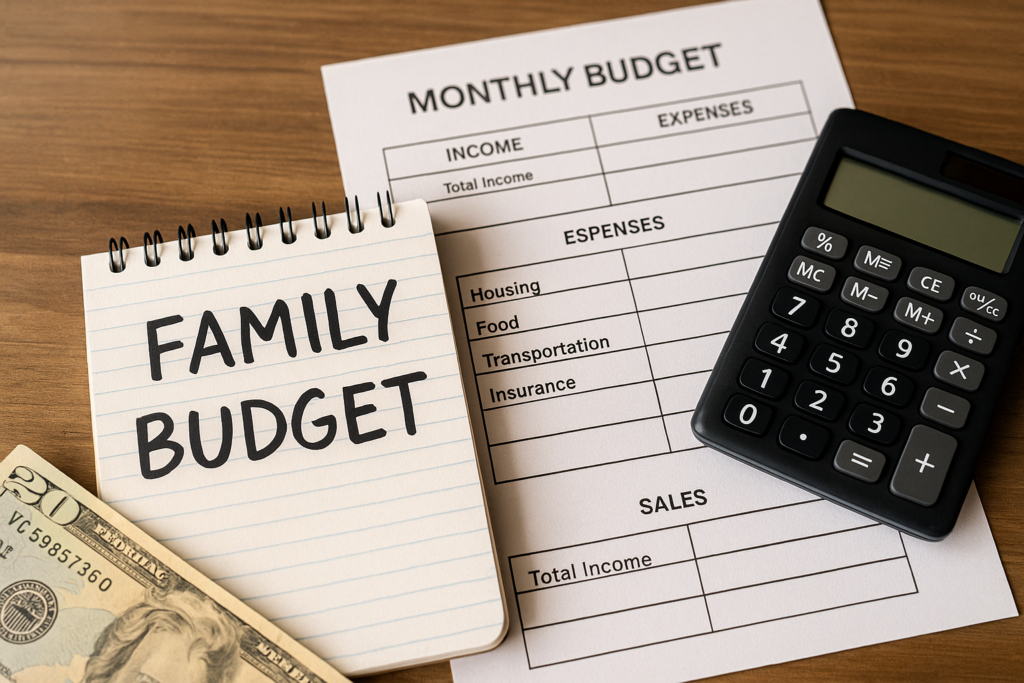
A family budget is more than just a spreadsheet with numbers—it’s a roadmap for achieving stability, peace of mind, and shared goals. Whether you’re saving for a home, managing day-to-day expenses, or just trying to stop living paycheck to paycheck, a realistic family budget can transform the way your household functions.
This guide will walk you through every step to build a family budget that is clear, achievable, and sustainable.
Why a Family Budget Matters
Before diving into the process, it’s important to understand why budgeting matters:
- It provides financial control and helps avoid debt.
- It helps you plan for emergencies and unexpected costs.
- It enables goal setting for things like vacations, education, or home renovations.
- It reduces stress and improves communication among family members.
Most importantly, a good budget aligns your money with your values.
Step 1: Understand Your Family’s Income
The first step in building a realistic budget is knowing exactly how much money comes in every month.
Include:
- Salaries and wages
- Freelance or side hustle income
- Government benefits (e.g., child support, social aid)
- Rental or passive income
- Any consistent financial support
Be honest and conservative—don’t include inconsistent bonuses or gifts unless they’re guaranteed.
Step 2: Track Current Spending Habits
Before setting limits or goals, you need to understand where your money is going right now. Track spending for at least a month:
- Use budgeting apps like Mint, EveryDollar, or Goodbudget
- Or log purchases manually in a notebook or spreadsheet
- Categorize expenses into:
- Fixed (mortgage, rent, insurance)
- Variable (food, fuel, entertainment)
- Occasional (birthdays, holidays, back-to-school)
You’ll likely discover areas where spending can be trimmed without major lifestyle changes.
Step 3: Categorize Your Expenses
Break your monthly expenses into clear categories so you can assign realistic limits. Common household budget categories include:
- Housing (rent/mortgage, utilities, maintenance)
- Transportation (fuel, public transit, insurance, car payments)
- Groceries (food, household supplies)
- Debt Payments (credit cards, student loans)
- Savings (emergency fund, retirement, education)
- Health (insurance, medications, doctor visits)
- Entertainment and Leisure
- Childcare and Education
- Miscellaneous (pet care, gifts, subscriptions)
Use average monthly totals to set your limits, adjusting as needed for seasonal changes.
Step 4: Use a Budgeting Method That Fits Your Family
There’s no one-size-fits-all approach. Choose a system that fits your lifestyle and discipline level:
50/30/20 Rule
- 50% for needs
- 30% for wants
- 20% for savings and debt repayment
Zero-Based Budgeting
- Every dollar is assigned a role until you have $0 left unassigned
- Excellent for families who want full control over their money
Envelope System
- Cash-based method where money is placed in labeled envelopes for each category
- Helps prevent overspending by making limits physical and visible
Try different systems until you find one that works for everyone involved.
Step 5: Set Clear, Achievable Goals
Budgeting without goals is like driving without a destination. Ask yourselves:
- Do we want to pay off a specific debt?
- Save for a family vacation?
- Build a six-month emergency fund?
Use SMART goals (Specific, Measurable, Achievable, Relevant, Time-bound) to stay on track. Example: “Save $500 in 3 months for a back-to-school fund.”
Step 6: Review and Adjust Weekly or Monthly
Your budget is a living document, not a fixed rulebook. Family needs and income will change—so review regularly.
- Hold monthly budget check-ins with your partner or family members
- Adjust based on unexpected expenses or new goals
- Celebrate wins—no matter how small
The key to success is consistency, not perfection.
Step 7: Involve the Whole Family
A budget only works if everyone is on board. Even children can understand the basics:
- Share your goals and priorities openly
- Assign age-appropriate roles (like tracking grocery prices or turning off lights to save energy)
- Encourage teenagers to budget their allowance or part-time income
Creating a culture of financial awareness early builds lifelong habits.
Step 8: Automate Where Possible
Take the mental load off by automating:
- Bill payments
- Savings transfers
- Investment contributions
- Budget notifications via apps
Automation prevents forgetfulness and builds savings painlessly.
A Budget That Works for You, Not Against You
A realistic family budget is not about restriction—it’s about freedom and clarity. It gives you the power to:
- Say “yes” to what matters
- Say “no” without guilt
- Reduce financial surprises
- Work toward your shared dreams
You don’t need to be a finance expert to succeed. Start simple, stay consistent, and make it a family effort. Your future self—and your whole household—will thank you.
